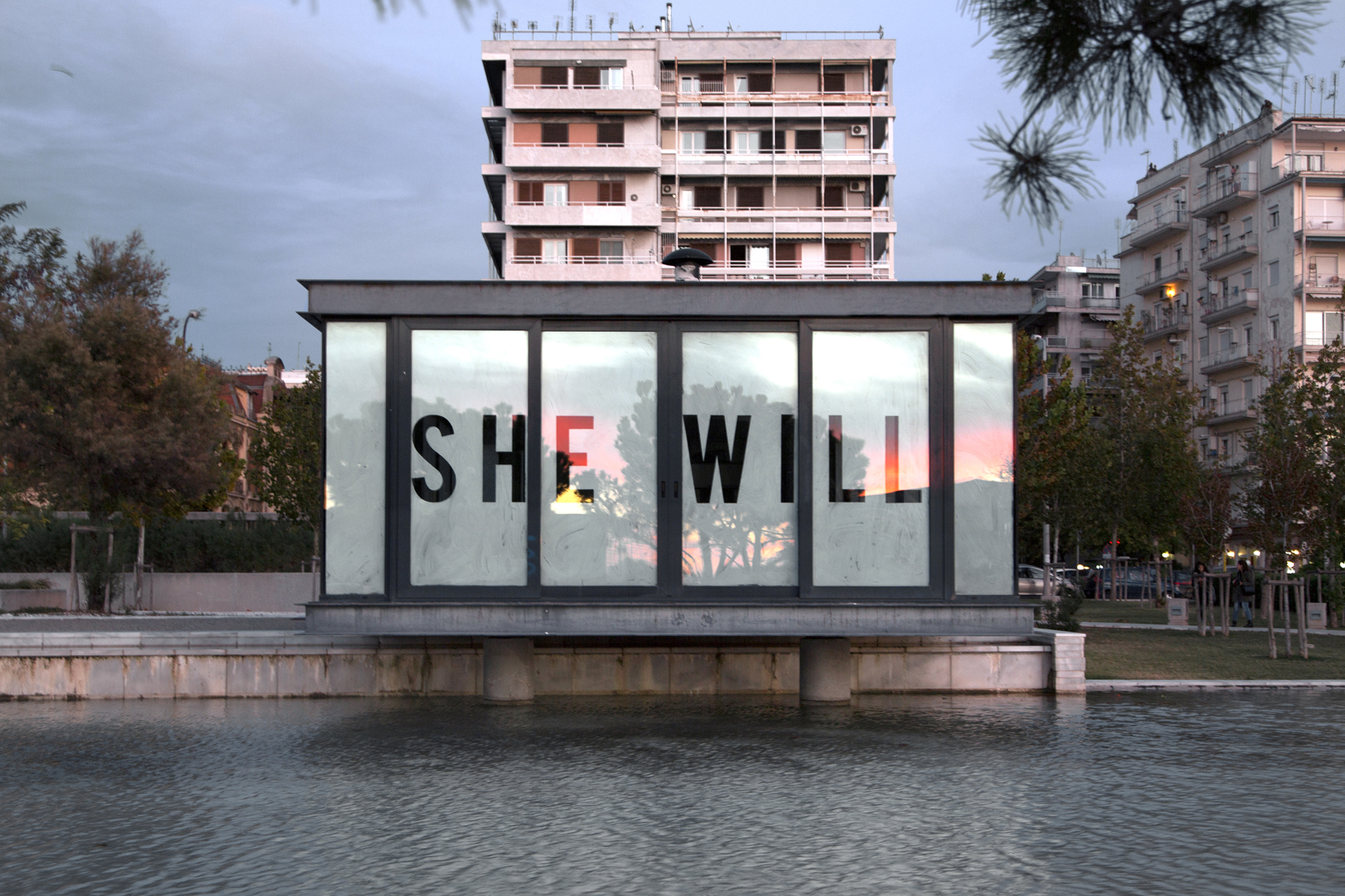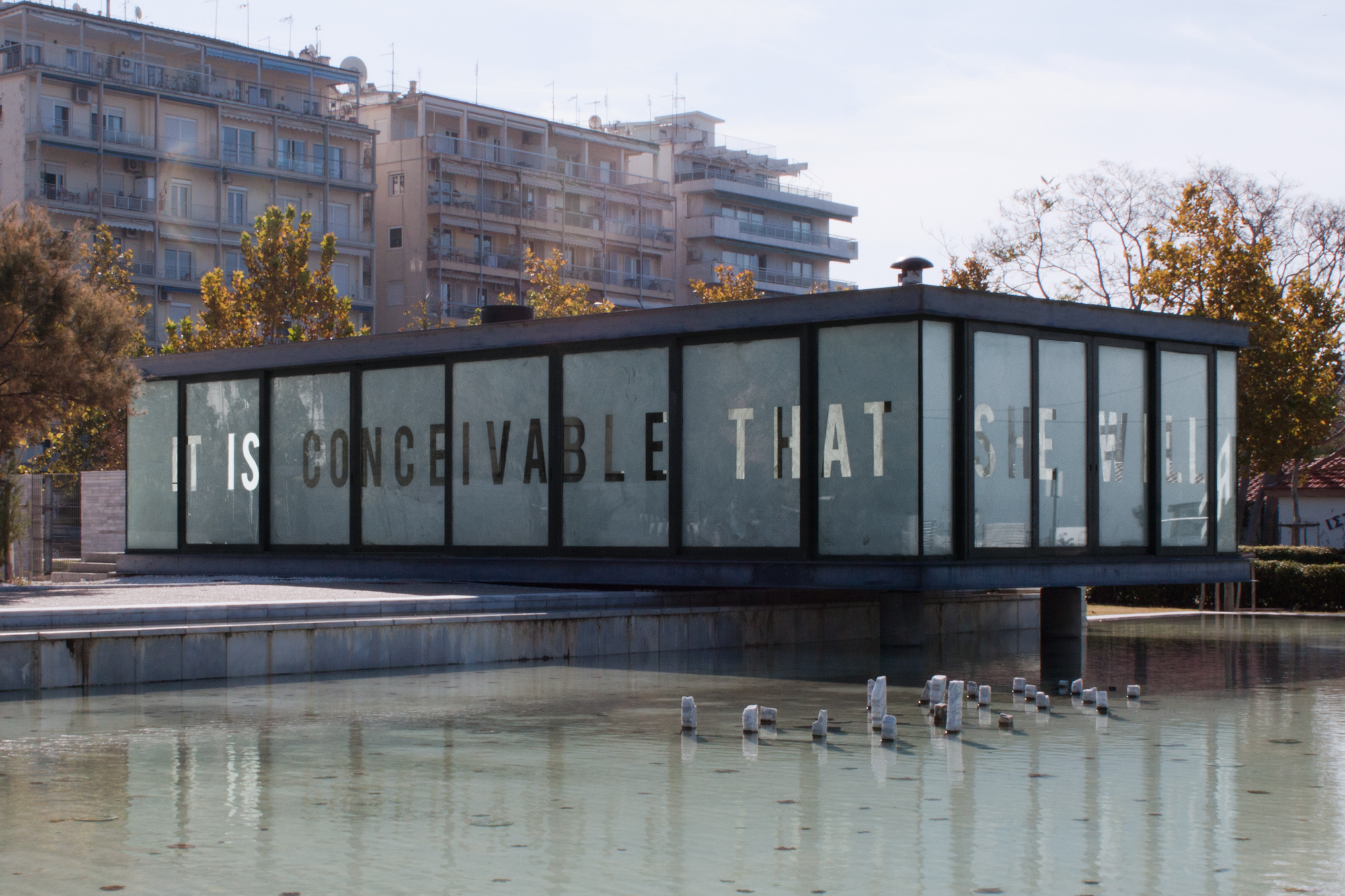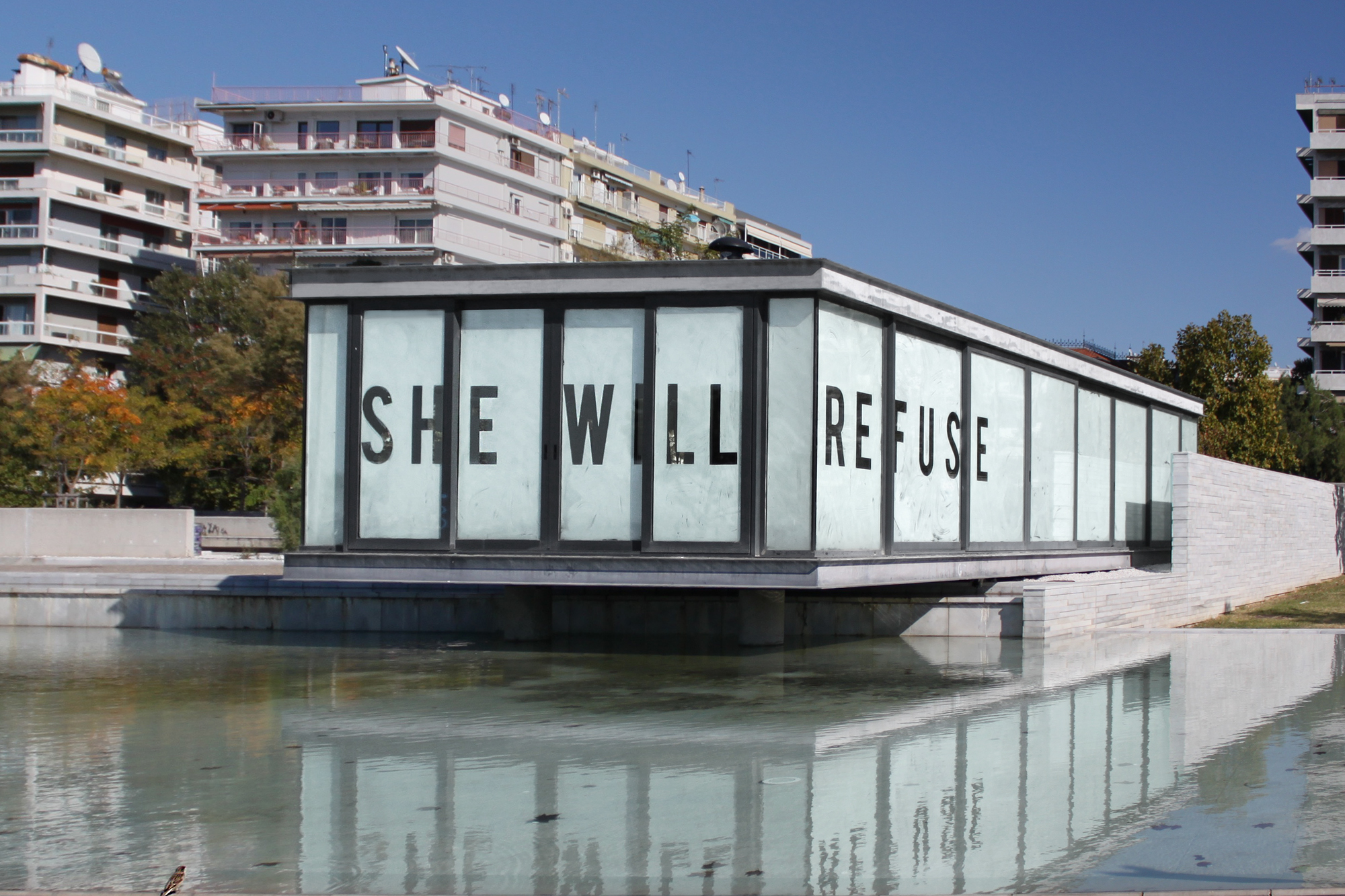The Museum of Contemporary Cuts presents a painterly and sculptural text work by Dutch artist, Willem Jan Smit. At the Sculpture Garden pavilion on the New Sea Waterfront of Thessaloniki, Smit marries the two media with the complexity of the positive and negative architectural space.
“The Sculpture Garden pavilion presents and shines a light on a fissure in the homogeneous representation of the community,” explains the artist. “The pavilion proposes a narrative of the unlikely rendered possible. It is a fiction and a reality at once. During the installation of the work, passersby would approach to ask for clarification on the nature of the development, filling in the blanks themselves and projecting their own unfulfilled desires. The fictional aspect of the work is about what may be coming soon or what the imagined scenario of this development could entail. Who will be using the space and what sort of community will it house? The reality is that new possibilities—unthinkable and not thought yet—are now open for exploration. This exchange creates an aesthetic fiction on the edge of reality.”
The artist’s concern with the disappearance of public spaces within which communities have been able to congregate, organize, and advance their agendas plays with the presence of multiple pavilions across the New Sea Waterfront of Thessaloniki. The Sculpture Garden pavilion in the hands of the artist becomes a community statement of what may be possible, raising the expectation that something new may be housed in it in response to the needs of the community.
“It Is Conceivable that She Will Refuse, is a layered artwork that plays in between the public and private spaces—explains the curator Lanfranco Aceti, research affiliate and visiting professor at Art, Culture, and Technology (ACT) in the Department of Architecture at MIT. The artist has been able to render visible the role of the ‘public house’ and its relationship to state legislation and its restrictions. It is a piercing of the architectonical space through which it is possible to see the failed negotiations at play—between unimaginable homes and the heteronormative restrictions imposed by a public arena.”
The aims of the artist are oriented towards the nurturing of a future wherein true emancipation and equal rights—regardless of race, sexual preference, or economic status—are conceivable for all beings, particularly those who are currently living under suspended or partial citizenship. Smit, moving from the Dutch experience of lesbian couples wanting to conceive via IVF—a successfully resolved issue in the Netherlands but not in Greece—extrapolated the general notion of conceivable in order to analyze the unthinkable that can be conceived and realized within the public space.
The artwork is constructed as a believable fiction—a conceivable space within which unthinkable possibilities of the public sphere are fertilized for evolution. This process allows the unimaginable and unimagined homes and family lives—gendered, racially, and economically excluded—to be included within the urban texture.
The artist has chosen to insert a questionable scenario, proposed equally in text as in material, about what is conceivable. The text is dubious because the subject is indistinct. What we do know is that the main character identifies as feminine and that it is possible for her to have her own will, but her primary trait is that she has free will, which poses the question, what are the oppressive forces on this feminine subject? The material suggests change, not necessarily progress, through the possibility of economic growth or investment. It also foregrounds typically gendered labour, window washing, erasure, and the ceaseless production of cleanliness. The painted windows function within the realm of scenography and are a common indicator that an interior is being modified, one can expect the establishment to open again soon respawning question of: “What is to come?”
For the Thessaloniki Biennial and their chosen theme, Imagined Homes, a progression of the imaginable spaces sparked imaginable community centres, pubs, clubs, raves, and lesbian, gay, and trans bars. The question of what is to come could be presented as the idea of the inclusion of the excluded collectives. Imagined Homes prompted the thinkable presence of the unheard minorities in the public sphere.
Conceivable is the operative word in this painterly and sculptural installation which, based on Merriam-Webster’s dictionary sample sentence, “It is conceivable that she will refuse to go,” was shortened to imply and implicate innumerable scenographies and scenarios—once unthinkable—to be conceived as possible.
It Is Conceivable that She Will Refuse was realized with the support of The Museum of Contemporary Cuts, Arts Administration at Boston University, and the Friends of Thessaloniki’s New Waterfront Association.
Artist Bio
Willem Jan Smit (NL, ES) is a contemporary artist and activist who is exhibiting internationally. Currently his work can be viewed at the Athens School of Fine Arts annex in Hydra and at Beton7 in Athens. Smit largely works in sculpture and installation though his practice, conceptually based, will assume whatever necessary form depending on each project’s requirements. Text and painting play an increasing role in his practice. His latest intervention was, Ad Nauseam, at documenta 14, shortly after a solo exhibition, They Were Shown the Door in a Matter of Minutes, in Athens as part of the Platforms Project for the Museum of Contemporary Cuts. For the fall he is engaging in a series of public works the first of which will be during the Thessaloniki Biennial. He studied in Vancouver, Canada with Liz Magor, Geoffrey Farmer, and Garry Neill Kennedy. His artworks are held in numerous private and public collections.
Curator Bio
Lanfranco Aceti works as a curator, artist, and academic. He is a research affiliate and visiting professor at ACT @ MIT and director of the Arts Administration Program at Boston University. As curator he previously worked as director of Kasa Gallery in Istanbul, where he exhibited a range of innovative artworks including 75Watts by Revital Cohen and Tuur Van Balen, acquired by MoMA and Paolo Cirio’s Loophole4All, awarded the 2014 Golden Nica at Ars Electronica. Recently, he curated End of a Summer Bliss at the Kalfayan Gallery, as well as The Small Infinite at the John Hansard Gallery with artworks never previously exhibited from the estate of John Latham. Lanfranco Aceti has participated in numerous art fairs such as Art Athina, Art International, Supermarket, and Contemporary Istanbul, either as a curator or as an artist. In 2011, he curated the exhibition Uncontainable as part of the parallel events of the 12th Istanbul Biennial and exhibited artworks on the media facade of the Museum of Contemporary Art, Zagreb. In 2016, he curated a range of artworks as part of THE SOCIAL at the Museum of Fine Arts, Boston, the Boston Athenaeum, the Victoria and Albert Museum, and other public spaces in Boston and London. In June 2017, he curated a new public performance, One Step Forward Two Steps Back, by Stefanos Tsivopoulos on the White House sidewalk in collaboration with the Cooper Gallery at Harvard University. He is currently curating Empty Pr(oe)mises for the National Museum of Contemporary Art, Athens.



